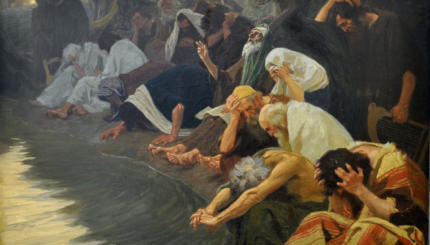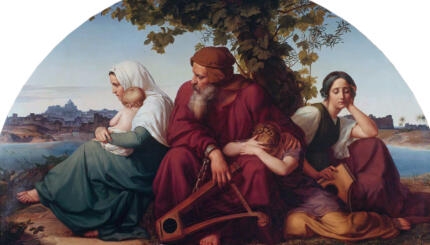Reprinted with permission from “Contemporary Israeli Fiction and the Subject of Fiction: From Nationhood to the Self,” published in Ideology and Jewish Identity, edited by Emily Miller Budick.
Already in the late 1950s the attitude of Hebrew fiction to the large ideological metaplot of Zionist history and realization began to change. There was a general sense of disillusion in the literary community, as what used to be a community of voluntary idealism turned into a bureaucratic state swamped by waves of immigration. The writers reflected the feelings of the cultural, intellectual, and political elite, which felt it was losing the identity that the Hebrew community had forged for itself since the 1920s.
The Sinai War, the Eichmann trial, the Lavon Affair–in which Israelis plotted, and failed, to blow up Americans and incriminate the Egyptians–the revolt against Ben Gurion, the Six Day and wars, and the political upheaval of the late 1970s–all of these events left their marks on creative people of all ages, but especially on the younger ones, for whom the Holocaust and the War of Independence had not been formative experiences.
 In the early 1950s Amos Kenan responded to the “outbreak of the State” in his satiric column “Uzi & Co” in the newspaper Haaretz. And in 1963 he returned to the subject in a modernist‑absurd novel Batahanah [At the Station]. But it was in the 1960s that the new, postrealist Hebrew fiction of disillusion took hold, with the first short story collections of A.B. Yehoshua (Mot Hazaken) [The Death of an Old Man] and
Appelfeld (Ashan) in 1962, followed by Yoram Kaniuk’s Hayored Lemalah [The Acrophyle] in 1963, Yehoshua Kenaz’s first novel Aharai Hahagim [After the Holidays] in 1964, and Amos Oz’s first short story collection Artzot Hatan [Where the Jackals Howl] in 1965.
In the early 1950s Amos Kenan responded to the “outbreak of the State” in his satiric column “Uzi & Co” in the newspaper Haaretz. And in 1963 he returned to the subject in a modernist‑absurd novel Batahanah [At the Station]. But it was in the 1960s that the new, postrealist Hebrew fiction of disillusion took hold, with the first short story collections of A.B. Yehoshua (Mot Hazaken) [The Death of an Old Man] and
Appelfeld (Ashan) in 1962, followed by Yoram Kaniuk’s Hayored Lemalah [The Acrophyle] in 1963, Yehoshua Kenaz’s first novel Aharai Hahagim [After the Holidays] in 1964, and Amos Oz’s first short story collection Artzot Hatan [Where the Jackals Howl] in 1965.

Help us keep Jewish knowledge accessible to millions of people around the world.
Your donation to My Jewish Learning fuels endless journeys of Jewish discovery. With your help, My Jewish Learning can continue to provide nonstop opportunities for learning, connection and growth.
Struggling against imaginary external censors and genuine internal ones, the major writers of this New Wave of Israeli authors (as they were dubbed) produced anti‑establishment allegories that to some degree veiled their intentions. This accounts for works like Mikreh Hakesil [Fortunes of a Fool] in 1959 and Haberihah [The Escape] in 1962 by Aharon Megged (a member of the older generation), as well as the early allegories of A. B. Yehoshua, which began to appear in the late 1950s in the newspaper Lamerhav and in the periodical Keshet.
Yehoshua’s story “Hamefaked Ha’aharon” [The Last Commander], for example, which appeared in the collection Mot Hazaken in 1962, is about a group of soldiers who prefer sleeping to fighting. It evokes the weary distaste for war felt by the post-Sinai Campaign generation.
A more direct response to the transformations in attitude effected by the Sinai Campaign and by the Lavon Affair was mounted in Yariv Ben‑Aharon’s book Hakerav [The Battle], which was published in 1967–the year of the Six Day War. In Or Be’ad Or [Skin for Skin] In 1962, Orpaz protested the war and the values that led up to it. So did Amos Oz in one of his major works of fiction, Mikha’el Sheli [My Michael]. Though the book appeared only in 1968, nonetheless its inner climax corresponds, not to the Six Day War, but to the Sinai Campaign. It discharged tensions that had built up during the years of living on the edge.
Various aspects of the Holocaust, which the Israelis had been unable to contend with directly, remained suppressed until the 1960s. Secular Zionism had rested on the negation of the Diaspora and Diaspora Judaism. The Eichmann trial revalidated the old Jew in Israeli eyes. The Jews who had been slaughtered were not guilty of anything, not even of having failed to heed the Zionist message in time. They were innocent victims of a hostile world. Therefore, the Jewish metaplot, of which the Zionist metaplot was one part, had to acknowledge these Jews as equally legitimate protagonists in the unfolding of the national narrative.
This realization concerning European Jewry took an even more radical turn following the Six Day War, in which the corollary of Diaspora weakness as opposed to Israeli strength and invulnerability, came to be tested. On the one hand, the impending conflict revitalized and revivified national myths, as the nation envisioned a second Auschwitz. Accordingly, one euphoric response to the victory of 1967 was a reconfirmation of divine promise and Zionist vision finally realized.
But such triumphalism angered many leftist intellectuals, whose outcry determined the dominant post‑1967 note, especially as Israel, in the wake of its self‑confidence, nearly lost the Yom Kippur War. In the autumn of 1974 the periodical Akhshav published a “we told you so” editorial, as if Israel’s near‑defeat at the hands of the Arabs was a sort of moral victory, not only for the political left, but for avant‑garde literature: “Are we, as writers and intellectuals, supposed to keep silent in the face of this foolish refusal which harms Israel, to recognize the right of the other nation in this country, namely the Palestinian people, to self‑determination at our side?”
Repelled by the exultant society around her, writers such as Ruth Almog, for example, in her novel Mavet Bageshem [Death in the Rain] in 1982, presented post‑1967 Israel as a land of contractors, snobs, and the newly affluent. Or take the following passage from Oz’s Laga’at Bamayim, Laga’at Baruah [Touch the Water, Touch the Wind] in 1973, which was published a little before the Yom Kippur War and is set in the moment of 1967:
“Yotan and Audrey…had decided that words were not enough. They resolved that it was their duty to set out that very night on foot for the mountains over the border. There they would try with all their might and main to meet, to talk, to explain, to persuade, to extinguish with the right words the flame of blind hatred. Not that they had any confidence in the success of their experiment, but they both shared a feeling that there was nothing else in the world to compare to it, even if it failed, and that the almost certain defeat they faced would be far more glorious than all the magnificent victories of which the history books are full.”
Amos Kenan went still further in his grotesque‑satiric novella, Shoah II (1975), in which he suggested that occupation, not the ’67 threat, would be what produced a second Holocaust.


